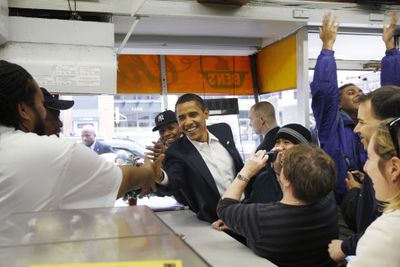Obama foresees 3.7 million jobs
But impact on jobless rate limited, study says

WASHINGTON – President-elect Barack Obama projected Saturday that his yet-to-be-written economic stimulus plan would create nearly 3.7 million jobs by the end of next year, mainly in construction, leisure services and manufacturing.
But the projected $775 billion plan won’t stop the nation’s unemployment rate from reaching about 8 percent by the end of this year, an analysis of the plan says, and will only have brought joblessness back to current levels by the end of 2010.
Obama’s release of the study based on a rough draft of his stimulus plan indicated he wants to get ahead of dismal economic news, economists said.
The latest hit came Friday, when Bureau of Labor Statistics numbers showed another 524,000 U.S. jobs vanished in December, lifting the national unemployment rate to 7.2 percent, its highest level in 16 years.
“This is a very honest picture of what a stimulus package would do, but it’s still not a very good story,” said Dean Baker, co-director of the liberal think tank Center for Economic and Policy Research. “It’s saying we’re in for some difficult times.”
The 14-page report warned the projections were subject to “significant margins of error” and were based on a “hypothetical package” of measures that must still undergo congressional scrutiny.
That didn’t stop Obama from promising massive job creation in his Saturday radio and Internet address.
“The jobs we create will be in businesses large and small across a wide range of industries,” the president-elect said. “And they’ll be the kind of jobs that don’t just put people to work in the short term, but position our economy to lead the world in the long term.”
The Obama plan promises to invest heavily in infrastructure, education, health and energy; send needed fiscal relief to states; increase unemployment insurance and food stamp funding; and cut middle-class taxes.
The projections show the plan creating 678,000 jobs in construction, 499,000 in leisure and hospitality, and 408,000 in manufacturing. The plan would also lower the national unemployment rate by 1.8 percentage points by the end of next year, the analysis said.
Those job fields are the same ones that showed the biggest cuts in Friday’s unemployment report, with about 1 million jobs disappearing in the construction and manufacturing sectors between December 2007 and last month.
The labor report also calculated a whopping 15.3 percent unemployment rate in construction and a 17 percent unemployment rate in agriculture and related fields.
How the analysis reached its conclusions was uncertain since Obama himself has acknowledged that there is no finished proposal. Speaking at a Friday press conference, Obama said he would work closely with the Democrat-controlled Congress to hammer out the details of his stimulus plan, which remains little more than broad principles.
“If members of Congress have good ideas, if they can identify a project for me that will create jobs in an efficient way, that does not hamper our ability to, over the long term, get control of our deficit, that is good for the economy, then I’m going accept it,” Obama said.
Baker said the stimulus plan will need to be much bigger if it’s going to make an impact. He suggested offering employers more tax breaks for providing health insurance to workers and increasing subsidies to public transportation.
Baker also urged Congress and Obama to work more quickly to pass the stimulus plan. Some Democratic legislators have warned that work on the plan could stretch on for weeks.
“Timing here is very important because every day we wait we’ll lose more jobs,” Baker said. “I’d like to see all of them be more ambitious.”